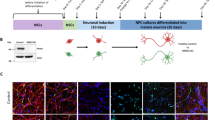Abstract
Loss-of-function mutations in the parkin gene have recently been shown to be responsible for autosomal recessive juvenile Parkinsonism. However, the exact mechanism of pathogenesis remains unclear. This study explores the effect of Parkin downregulation on dopaminergic cells in Parkinson’s disease. We generated small interfering RNA plasmids that target the parkin gene and transfected them into PC12 cells to mimic in vivo loss-of-function. We found that these small plasmids were able to effectively inhibit endogenous Parkin expression in PC12 cells. Downregulation of Parkin decreased the amount of glutathione and superoxide dismutase activity without affecting the amount of malondialdehyde. Moreover, Parkin knockdown rendered PC12 cells more susceptible to cell death induced by the proteasome inhibitor lactacystin. These results indicate that downregulation of Parkin may damage the antioxidation defenses of dopaminergic cells and increase their susceptibility to proteasome inhibitor-induced toxicity.




Similar content being viewed by others
References
Corti O, Hampe C, Koutnikova H, Darios F, Jacquier S, Prigent A, Robinson JC, Pradier L, Ruberg M, Mirande M, Hirsch E, Rooney T, Fournier A, Brice A (2003) The p38 subunit of the aminoacyl-tRNA synthetase complex is a Parkin substrate: linking protein biosynthesis and neurodegeneration. Hum Mol Genet 12:1427–1437
Fire A, Xu S, Montgomery MK, Kostas SA, Driver SE, Mello CC (1998) Potent and specific genetic interference by double-stranded RNA in Caenorhabditis elegans. Nature 391:806–811
Goldberg MS, Fleming SM, Palacino JJ, Cepeda C, Lam HA, Bhatnagar A, Meloni EG, Wu N, Ackerson LC, Klapstein GJ, Gajendiran M, Roth BL, Chesselet MF, Maidment NT, Levine MS, Shen J (2003) Parkin-deficient mice exhibit nigrostriatal deficits but not loss of dopaminergic neurons. J Biol Chem 278:43628–43635
Hyun DH, Lee M, Halliwell B, Jenner P (2003) Proteasomal inhibition causes the formation of protein aggregates containing a wide range of proteins, including nitrated proteins. J Neurochem 86:363–373
Imai Y, Soda M, Murakami T, Shoji M, Abe K, Takahashi R (2003) A product of the human gene adjacent to parkin is a component of Lewy bodies and suppresses Pael receptor-induced cell death. J Biol Chem 278:51901–51910
Jenner P, Olanow CW (1996) Oxidative stress and the pathogenesis of Parkinson’s disease. Neurology 47:S161–S170
Kitada T, Asakawa S, Hattori N, Matsumine H, Yamamura Y, Minoshima S, Yokochi M, Mizuno Y, Shimizu N (1998) Mutation in the parkin gene cause autosomal recessive juvenile Parkinsonism. Nature 392:605–608
Kobayashi T, Wang M, Hattori N, Matsumine H, Kondo T, Mizuno Y (2000) Exonic deletion mutation of the parkin gene among sporadic patients with Parkinson’s disease. Parkinsonism Relat Disord 6:129–131
Li K, Ito H, Tanaka K, Hirano A (1997) Immunocytochemical co-localization of the proteasome in ubiquitinated structures in neurodegenerative diseases and the elderly. J Neuropathol Exp Neurol 56:125–131
Lucking CB, Durr A, Bonifati V, Vaughan J, De Michele G, Gasser T, Harhangi BS, Meco G, Denefle P, Wood NW, Agid Y, Brice A (2000) Association between early-onset Parkinson’s disease and mutation in the parkin gene. N Engl J Med 342:1560–1567
McNaught KS, Olanow CW (2003) Proteolytic stress: a unifying concept for the etiopathogenesis of Parkinson’s disease. Ann Neurol 53(Suppl 3):S73–S84
McNaught KS, Belizaire R, Jenner P, Olanow CW, Isacson O (2002) Selective loss of 20S proteasome alpha-subunits in the substantia nigra pars compacta in Parkinson’s disease. Neurosci Lett 326:155–158
McNaught KS, Belizaire R, Isacson O, Jenner P, Olanow CW (2003) Altered proteasomal function in sporadic Parkinson’s disease. Exp Neurol 179:38–46
Palacino JJ, Sagi D, Goldberg MS, Krauss S, Motz C, Wacker M, Klose J, Shen J (2004) Mitochondrial Dysfunction and Oxidative Damage in parkin-deficient Mice. J Biol Chem 279:18614–18622
Shi Y (2003) Mammalian RNAi for the masses. Trends Genet 19:9–12
Shimura H, Hattori N, Kubo S, Yoshikawa M, Kitada T, Matsumine H, Asakawa S, Minoshima S, Yamamura Y, Shimizu N, Mizuno Y (1999) Immunohischemical and subcellular localization of Parkin: absence of protein in AR-JP. Ann Neurol 45:668–672
Shimura H, Hattori N, Kubo S, Mizuno Y, Asakawa S, Minoshima S, Shimizu N, Iwai K, Chiba T, Tanaka K, Suzuki T (2000) Familial Parkinson disease gene product, parkin, is a ubiquitin-protein ligase. Nat Genet 25:302–305
Takanashi M, Mochizuki H, Yokomizo K, Hattori N, Mori H, Yamamura Y, Mizuno Y (2001) Iron accumulation in the substantia nigra of autosomal recessive juvenile Parkinsonism (ARJP). Parkinsonism Relat Disord 7:311–314
Acknowledgments
We would like to thank Professor Youxin Jin for the plasmid pUB and the plasmid pEGFP-C1. This work was funded by the National Program of Basic Research (2006cb500700) of China, the National Natural Science Foundation of China (30471918), and Shanghai Key Project of Basic Science Research (04DZ14005).
Author information
Authors and Affiliations
Corresponding author
Rights and permissions
About this article
Cite this article
Yang, H., Zhou, HY., LI, B. et al. Downregulation of Parkin Damages Antioxidant Defenses and Enhances Proteasome Inhibition-Induced Toxicity in PC12 Cells. Jrnl Neuroimmune Pharm 2, 276–283 (2007). https://doi.org/10.1007/s11481-007-9082-2
Received:
Accepted:
Published:
Issue Date:
DOI: https://doi.org/10.1007/s11481-007-9082-2




